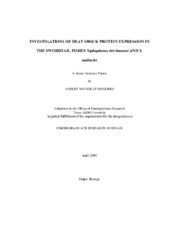| dc.description.abstract | In many species, animals must endure environmental stressors such as exposure to heat,
toxins, and ultraviolet radiation. To protect cells against such stressors, animals employ an evolutionarily ancient mechanism: the heat shock response. During a heat shock
response, heat shock proteins (Hsps) act as “chaperones,” assisting in maintaining the
appropriate conformation of other critical proteins which would otherwise be denatured. Samples from three populations of swordtail fishes were collected from the Sierra Madre
Oriental in Mexico to study the relationship between the amount of natural thermal stress
and the quantity of Hsps expressed. In each population, HSP70 and HSP90 were quantified in fish taken directly from the natural environment and fish that underwent an acute heat stress experiment. In both cases, the population that experienced very little environmental heat stress expressed significantly less Hsps than the population that experienced much greater natural thermal variation. If climate temperatures within the Sierra Madre Oriental significantly rise, the swordtail population with the least
expression of Hsps will have a significantly lower chance at survival than the swordtail population with the highest expression of Hsps. | en |


